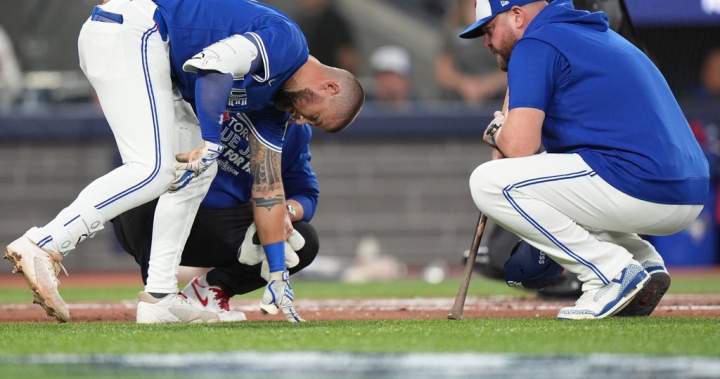The owner of a Downtown Eastside restaurant on a block with one of the highest crime rates in Vancouver says the irony of all the drug use, dealing and street disorder happening outside his doors is something he tries not to think about as he struggles to run a legal business.
At the same time, stakeholders are urging the provincial and federal governments to step up and play a bigger role in tackling the root cause of the area’s illegal activity, which continues to thrive.
Before the Vancouver Police Department’s (VPD) Task Force Barrage brought an increased police presence and foot patrols to Carrall Street near Hastings earlier this year, Calabash Bistro said co-existing with drug dealers has helped them survive for the past 15 years.
“The reality is, is that we’ve had to create a mutual respect between our business and all the business that happens out there,” Cullin David told Global News in an interview.
Story continues below advertisement

Downtown Eastside business struggles to stay open amid rampant public disorder
“Sometimes they’re the only person on the block who can deal with an addict who’s literally just done their drugs but is now passed out in front of my restaurant.”
The one block radius of Carrall Street and Hastings was known as a hot spot for loitering, street vending, drug trafficking and disorder, according to Insp. Gary Hiar, the commanding officer of Task Force Barrage.
Area crime, Hiar said, has decreased since the dedicated police task force began targeting violent offenders and organized criminals on Feb. 13.
Statistics provided by the VPD show violent incidents on the block are down 30 per cent from 137 in the period between Feb. 13 and June 15 in 2024 to 96 over the same four months this year.
Common assaults have decreased by 40 per cent from 62 in 2024 to 37 this year, serious assaults are down 21 per cent from 34 to 27, robberies have been reduced 62 per cent from 13 to five this year and commercial break and enters are down 75 per cent from eight in 2024 to two in the same four months this year.
Story continues below advertisement
“Looking at numbers is one thing, but if the perception is still that it’s not safe, then we need to do more,” said Hiar, the commanding officer of Task Force Barrage.
While he appreciates the extra police presence, David said it has also introduced new crews to the block, who are trying to take over as existing criminal networks are disrupted.

Get breaking National news
For news impacting Canada and around the world, sign up for breaking news alerts delivered directly to you when they happen.
“We’re always prepared, that you know, that squeeze on the core of the Downtown Eastside could lead to some disruption or some displacement, I should say,” Hiar responded.

New security cameras for Vancouver’s Downtown Eastside
In terms of shifting crime elsewhere, Hiar believes police are keeping a handle on it with additional resources on the outskirts of the area.
Early Sunday morning, David said his cooks had a close call when dealers from the “night shift,” who he said are often armed, drunk or high and much more dangerous than their counterparts on the day shift, attempted to stash something in Calabash’s commissary after spotting police on patrol.
Story continues below advertisement
The tense confrontation that ensued between his staff and approximately 10 aggressive individuals was only defused, said David, when a dealer they know intervened.
“First and foremost, if those types of tensions exist, we need to be called, we need to know because we have the patrols in and around the area, and we’re going to respond,” Hiar told Global News on Tuesday.
Terry Yung, B.C.’s Minister of State for Community Safety and a former VPD officer who walked the beat in the Downtown Eastside for more than four years, said targeted enforcement of the area’s criminal activity will continue, as well as addressing street conditions in the Carrall Street laneway between Hastings and Pender Streets.
“I understand the challenges and sometimes the fear of coming down here,” Yung told Global News in an interview. “That’s the reason I go to work in the morning and do this, because I do believe we can make a difference. Maybe not overnight to solve all the issues that we face, but we can make incremental progress.”
The Hastings Crossing Business Improvement Association said it is supporting David and other businesses as much as it can with safety and security.
“No business owner should have to risk their life to keep their business open,” executive director Landon Hoyt said in an interview. “What (David is) facing and what his staff are facing is extreme and something we’ve never seen before.”
Story continues below advertisement

Task Force Barrage sees dip in DTES crime, Vancouver police say
Trending Now
Hoyt said the province promised investment and change in the years preceding the 2010 Olympic Winter Games, noting Carrall Street was celebrated as one of the city of Vancouver’s first separated bike paths, but said the community has since been neglected.
“This neighbourhood has not gotten what it deserves,” Hoyt told Global News. “It’s just resulted in abandonment, really, and a crumbling neighbourhood.”
Hoyt said his local BIA can only do so much but has advocated relentlessly for the government to address the service gaps in the Downtown Eastside, including through a new Vancouver Agreement.
“Something that actually lays out and defines clear levels of responsibility for all different levels of government. That’s something that would lead to change in this community,” said Hoyt.
Signed in March 2000, the initial Vancouver Agreement was a five-year collaboration involving the federal, provincial and municipal governments. It focused on three main areas: community health and safety, economic and social development, and community capacity building.
Story continues below advertisement
According to a B.C. government press release, Vancouver Agreement partners announced more than $2.8 million on Jan. 21, 2003, for new programs aimed at revitalizing the Downtown Eastside economically and socially.

Retiring VPD chief reflects on policing the Downtown Eastside
In April 2005, all three levels of government announced that the Vancouver Agreement would be renewed for a second five-year term lasting until March 2010.
“The Agreement’s first focus is the revitalization of the city’s Downtown Eastside, particularly encouraging local business attraction and retention, secure and safe housing, and support for residents with addiction and mental health issues,” stated an April 4, 2005, news release on its renewal.
The Vancouver Agreement was not renewed after it expired in 2010, and the city of Vancouver confirmed there is currently no similar framework in place.
Green Party Coun. Pete Fry said we are not meeting the root causes of problems in the area, and agreed the Vancouver Agreement approach needs to be revisited so all levels of government are brought in to look for proactive solutions.
Story continues below advertisement
“How do we knit together federal policy, provincial policy, civic bylaws, policing, all those pieces?” Fry told Global News in an interview. “We need to get everybody at the same table and figure out what are some of the tangible solutions because what’s happening right now isn’t working.”
“It makes me wonder what the heck I’m doing down here,” said David.
The bistro owner told Global News it would probably be safer selling drugs on Carrall Street than trying to run a restaurant, adding he and his staff have turned down offers of $500 a day to work the block.
“To know that’s the amount of money that can be made for standing on a corner while my business is failing, is so incredibly heartbreaking,” said David.








